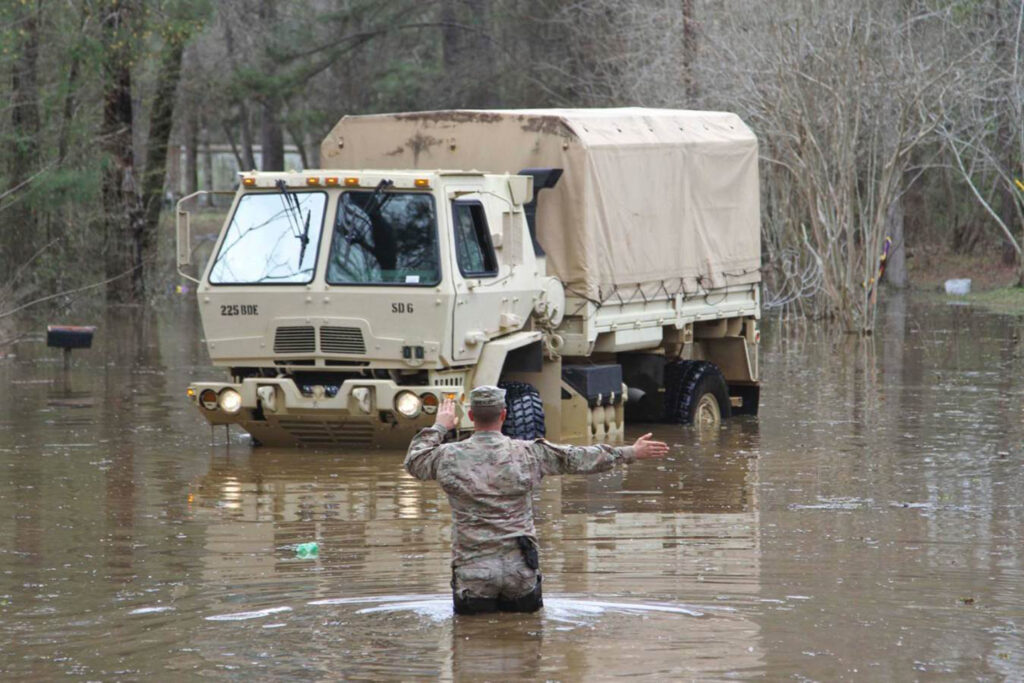National Guard Sgt. David Breaud directs a high-water vehicle down a flooded road in Grant Parish, Louisiana, following torrential downpours in March 2016. Military support for civil authorities during natural disasters is a key part of the resilience strategy.
ELENA FARNSWORTH
To compete globally, we must be strong at home.
These words serve as a pillar of United States Northern Command’s (USNORTHCOM) strategy to protect the U.S. homeland. While he leads this mission, USNORTHCOM’S commander also is designated as the Department of Defense (DOD) coordinator during execution of defense support to civil authorities (DSCA) operations within the USNORTHCOM area of responsibility (AOR).
A key aspect of homeland defense and DSCA is resilience. Resilience is the ability to adapt to changing conditions and withstand and rapidly recover from disruptions such as severe weather and power outages or malign acts such as terrorism and cyberattacks.
While the Department of Homeland Security takes the lead on resilience guidelines and protection of U.S. critical infrastructure, the DOD takes responsibility for the defense of critical infrastructure (DCI). Yet military facilities and missions often rely on civilian power grids, transportation and other critical infrastructure, so the DOD has established policies and programs to collaborate with key mission partners on critical infrastructure security and cybersecurity responsibilities. This ensures that key critical infrastructure remain defended and resilient to attacks.
The 2024 defense budget request is the largest defense budget in nominal terms in U.S. history at $842 billion. It is also the most strategy-aligned budget in history, consistent with the president’s National Security Strategy and the 2022 National Defense Strategy. The budget prioritizes building a resilient joint force and defense ecosystem. The budget also invests approximately $6 billion for strengthening the defense industrial base, supply chains and defense-critical sectors.
The DOD is adapting military facilities to improve mission resilience in an increasingly challenging threat environment. This includes deploying technologies that strengthen the ability to rapidly recover from disruptions to public infrastructure and modernizing defense operations to keep pace with industry.
USNORTHCOM’s policies and actions support the DOD. Part of the North American Aerospace Defense (NORAD) and USNORTHCOM theory of success involves improving critical infrastructure resilience and strengthening partnerships. These are key aspects in maintaining a globally integrated layered defense (GILD), which is made up of three layers. A forward layer consists of forward-deployed U.S. forces integrated with allies and partners. An approaches layer consists of joint-force capabilities integrated with capabilities from the Bahamas, Canada and Mexico. Finally, a homeland layer consists of joint-force capabilities integrated with whole-of-government/interagency and strategic private-sector partner capabilities.
This layered approach provides for redundancies, which in turn creates resilience. Should one portion of the defense be attacked and fail, more capabilities are ready and waiting. Redundancy and resilience go hand in hand.
Gen. Glen D. VanHerck, commander of NORAD and USNORTHCOM, stresses the importance of implementing modernized joint all-domain command and control, which relies on resilient and redundant communications systems to ensure rapid, accurate and secure dissemination of decisions.
VanHerck has also stressed the need for continued investments into threat-warning systems such as over-the-horizon radar, which affords more complete all-domain awareness and superior decision-making. The U.S. and Canada employ these systems as part of their partnership for continental defense, which has an unrivaled legacy of success through the 65-year-old binational command NORAD. The U.S.-Canadian integration demonstrates resilience in the face of multiple and complex threats, and the ability to defend the two homelands from provocations or attacks before they begin.
However, as the GILD strategy shows, homeland defense is a complex mission that consists of far more than reliable and resilient radar and ballistic missile systems.
Homeland defense efforts are not limited to North America. USNORTHCOM recognizes how Chinese and Russian capabilities present an all-domain threat. For example, Russia’s actions in Ukraine threaten European allies and other U.S. combatant commands. USNORTHCOM therefore stands ready to support the European Command in its efforts regarding Russian aggression in Ukraine and the U.S. Indo-Pacific Command to counter the People’s Republic of China’s malign-influence activities.
Additionally, though DSCA and homeland defense are separate missions, they overlap and reinforce each other. As a military command, USNORTHCOM has highly trained and specialized elements that are uniquely suited to support federal partners in the aftermath of a chemical, biological, radiological or nuclear attack. USNORTHCOM stands ready to respond immediately should a weapon of mass destruction event occur in the U.S.
USNORTHCOM also synchronizes and supports federal, state, tribal, territorial and local disaster relief, including hurricanes, forest fires, floods and earthquakes.
In his March 2023 statement before the House Armed Services Committee, VanHerck stated: “These collaborative whole-of-government efforts demonstrate national resilience that should reassure the American public, while also making clear to potential aggressors, that the United States routinely executes interagency domestic relief operations that allow our nation to recover quickly following even large-scale disasters.”
In summary, USNORTHCOM fosters resilience in homeland defense, which is critical in deterring adversaries from threatening the homeland and in ensuring a safe and secure North America.
Elena Farnsworth received her master’s degree in international security and homeland security at the Josef Korbel School of International Studies at the University of Denver. She interned with USNORTHCOM as part of the NORAD and USNORTHCOM Volunteer Student Intern Program.
“These collaborative whole-of-government efforts demonstrate national resilience that should reassure the American public, while also making clear to potential aggressors, that the United States routinely executes interagency domestic relief operations that allow our nation to recover quickly following even large-scale disasters.”
– Glen D. VanHerck, commander, North American Aerospace Defense Command and U.S. Northern Command

